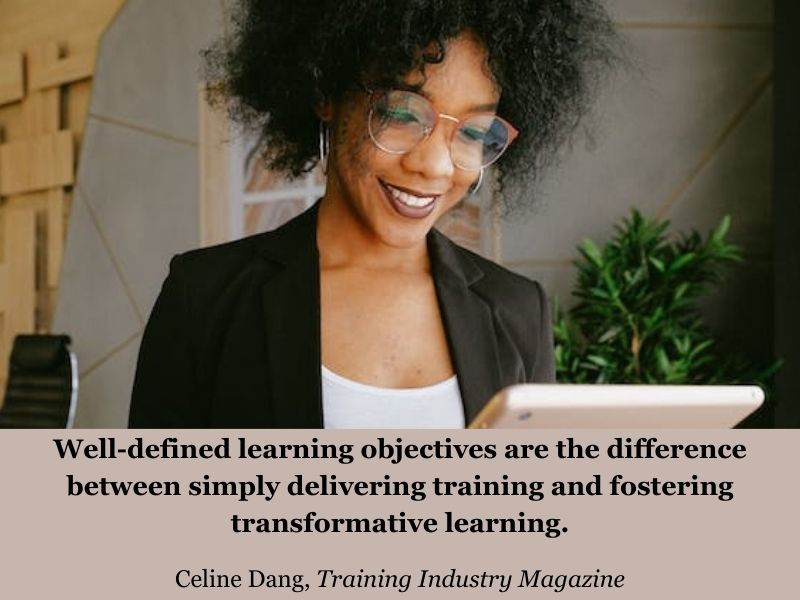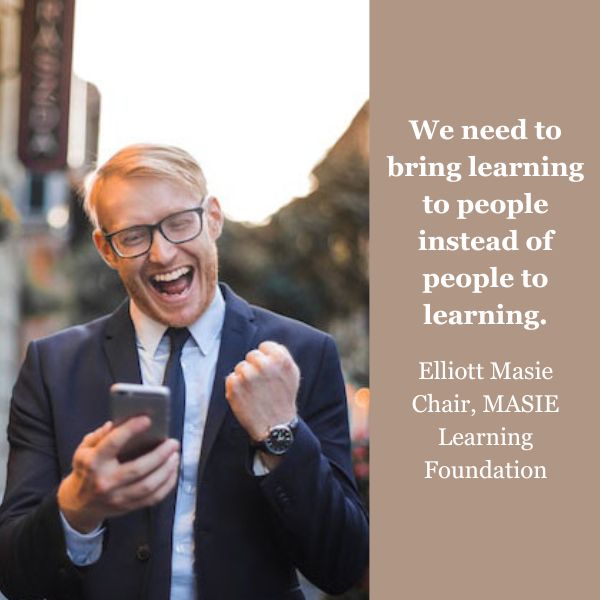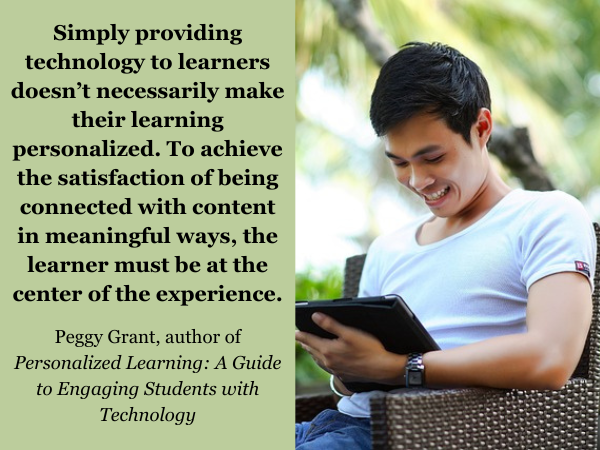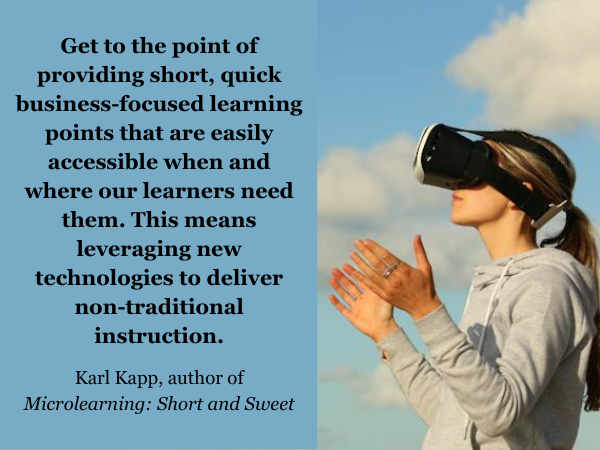This is the eighth and final post in our series about microlearning.
In today’s fast-paced corporate landscape, traditional training methods are being reshaped by the rise of microlearning. Microlearning delivers bite-sized learning units that focus on specific learning objectives, making it an ideal solution for busy professionals seeking to efficiently enhance their skills. In fact, organizations relying on microlearning for mobile devices, how most microlearning is accessed, saw a 16 percent boost in productivity from their workers. When done right, microlearning can significantly improve employee engagement, knowledge retention, and overall training effectiveness. However, creating impactful microlearning modules requires careful planning and adherence to best practices. Let’s discuss essential strategies instructional designers (ID) use for designing and implementing successful microlearning modules.

Identify Clear Learning Objectives
You can’t get to your destination if you don’t know where you’re going. Defining clear learning objectives before diving into the “fun” creative process is key to developing impactful microlearning. What does the team need to learn or achieve through your microlearning module? Whether it’s mastering a new software tool, understanding compliance regulations, or developing soft skills, well-defined goals will guide the content creation process and ensure relevance to learners’ needs. These strategies help instructional designers create objectives, in cooperation with organizational leadership teams:
- Connect with business goals. Aligning learning objectives to larger business goals and strategic plan is crucial.
- Be specific. Clearly communicate what learners should be able to do after completing their training. Action verbs such as “identify,” “apply,” or “create” should be used for further clarity.
- Ensure relevance. Keep the objectives pertinent to the learners’ roles to maintain engagement and applicability.
- Create measurable goals. Ensure that learning objectives are measurable so you, the learner, and their supervisor know if the goals are met.
Don’t forget to keep microlearning objectives singular and specific. Knowing what knowledge or skills learners need to acquire by the end of the training both streamlines the creation process and ensures you don’t include irrelevant information.

Keep it Concise and Focused
The essence of microlearning lies in its brevity, and its strength is in delivering key takeaways that are essential for learners. It’s perfect for providing just-in-time learning resources that employees can access whenever they need information, no matter their location. Keeping these tips in mind while developing modules will help you stay on track:
Keep each module focused on delivering a single learning point or skill by avoiding unnecessary complexity and information overload. Instead, strive for simplicity and clarity. You only have a few minutes to impact an individual, so it’s best to choose one idea per module.
- Create modules that address usual challenges or tasks that workers encounter in their day-to-day jobs, empowering them to quickly find solutions or refresh their knowledge.
- Don’t distract the learner or take up their valuable time with unimportant information. Remember: less is more, so include need-to-know information, not nice-to-know information.
- A typical office worker averages 11 minutes of work between interruptions. Trainings longer than 11 minutes are less likely to impact the user than shorter modules.
- Keep the “attention economy” in mind. You are competing with a lot of noise while trying to maintain a learner’s attention. They are used to the fast pace and quick delivery of internet content, so keeping training focused is essential.
- Check in with goals and learning objectives often. Don’t bore experienced learners with information they already know, and don’t overwhelm new learners with too much content.

Utilize Multimedia and Interactive Elements
Young Winston Churchill probably would have enjoyed microlearning, as the interactive elements would have kept his mind engaged. Multimedia elements enhance engagement and retention while catering to a variety of learning preferences. Improve the impact of your training by:
- Including multimedia elements like videos, infographics, and quizzes to help learners remember new information or skills.
- Creating augmented reality (AR) and virtual reality (VR) scenarios to help users apply what they’ve learned to real-world situations in a risk-free environment. A study from PwC (a leading professional services firm) shows that 40 percent more VR learners improved their confidence when compared to in-person classroom learners.
- Understanding what type of audio and visual elements works best for your content, audience, and delivery method.
- Adding these interactive elements to text to help learners process and retain information better and faster.
- Using only features that are relevant to the text, avoiding distracting the learner without adding value.
- Offering the same information in a variety of ways to help learners with different preferences stay engaged and motivated.
Remember the Ebbinghaus Forgetting Curve when designing microlearning trainings. According to 19th century German psychologist Hermann Ebbinghaus, humans forget 50 percent of all new information in a day, and 90 percent in a week. Repeating information using a variety of multimedia features improves retention.

Ensure Accessibility Across Devices
With the prevalence of mobile devices, ensure that your microlearning modules are accessible across various platforms and devices:
- Optimize content for mobile viewing, allowing employees to engage with training anytime, anywhere.
- Use a combination of formats such as videos, podcasts, quizzes, infographics, games – even VR scenarios.
- Choose interactive elements that work best for your content, audience, and delivery method.
- Enable offline access, as workers may not always have an internet connection.
Keep in mind that microlearning is mostly intended for employees on the move. Wherever the user is they can interact with a quick five-minute module using their phone or tablet: the daily commute (public transit, not driving!), during a commercial break, or waiting to pick up the kids at school. The possibilities are nearly endless. Better yet, organizations relying on mobile learning saw a 16 percent boost in productivity and other improvements.
Foster Interactivity and Feedback
Encourage active participation and learning reinforcement through interactive elements such as quizzes and knowledge checks. Interactive elements help learners avoid distractions and improve their performance by:
- Simplifying complex information.
- Promoting retention.
- Making new concepts easy to understand.
- Instilling and naturally building the confidence to complete tasks.
Here’s a quick fact: 80 percent of employees who say they have received meaningful feedback in the past week are fully engaged with their work – regardless of their status as a remote, hybrid, or full-time office employee. Real-time feedback is crucial to successful microlearning trainings, highlighting correct answers and offering explanations for incorrect responses. Such a feedback loop reinforces learning and helps users gauge their progress. It also helps them:
- Increase knowledge retention.
- Engage in constructive discussion with other online learners.
- Boost self-esteem.
- Persevere through challenging material.

Personalize Learning Experiences
According to an EdTech Review study, learners using personalized learning technology showed a 15-20 percent higher retention rate compared to those using traditional training methods. Customizing microlearning content to the specific needs and preferences of individual learners enhances engagement and motivation, ensuring the learning experience resonates with each employee’s unique requirements. Methods of personalized learning include:
- AI algorithms. These analyze a learner’s interactions with content to tailor a learning journey built just for them, promoting personalized and adaptive learning for better results. AI can assess the learner’s proficiency and dynamically adjust the content and difficulty level, ensuring that all receive a tailored experience, enhancing engagement and maximizing the training’s impact.
- Personalized learning plans. Create individual training goals, offer learners their choice of lessons from a catalog of topics, and ensure the platform you use supports such learning paths.
- Varied content. We don’t all have the same learning preferences. For example, some prefer text-based content and others learn more easily from interactive games. Using a variety of elements ensures everyone can learn using their preferred methods, which enables them to better understand and retain knowledge.
- Just-in-time job aids. Quick reference guides, tips, infographics, etc. help learners access the specific information they need at the exact moment they need it.
- Branching. IDs construct multiple paths for a learner to follow depending on their answers to previous questions or situations. If a learner must choose from several responses, whichever they choose will take them to the topic affiliated with that answer, helping to maximize their time.
Effective modules support and adapt to individual learning needs, and IDs should help users learn new skills in a way that works best for that person. Leverage data analytics and learner feedback to customize content delivery, recommendations, and learning paths.

Track and Measure Learning Outcomes
Implement robust analytics and tracking mechanisms to monitor learner progress, participation rates, and knowledge retention. Assess the effectiveness of microlearning modules by collecting data on completion rates, quiz scores, and performance improvements. Use these insights to iteratively refine and optimize future modules for greater impact. Here are some key metrics for measuring the impact of microlearning:
- Completion rates. When microlearning modules are created so that the learner cannot continue until answering a few assessment questions, you know they aren’t simply speeding through the training but are learning information to better perform their duties.
- Performance metrics. Correlating microlearning participation with key performance indicators (KPIs) relevant to one’s job role enables organizations to assess a training’s effectiveness on productivity and performance.
- Retention rates. Ask learners to take an assessment a week and then a month after completing a microlearning module to measure how well they retain information. Also observe their work to see if they are applying their new knowledge on the job.
- Assessment scores. Analyzing the performance of learners in assessments or quizzes associated with microlearning modules gauges their comprehension and mastery of the material. Conduct pre- and post-training tests that ask the same questions, then compare results.
- Qualitative feedback. Not everything can be tracked with simple metrics. A team member’s quality of work is best determined by their direct supervisor. Comments from other team members are also helpful.
- Application of knowledge. Observing how learners apply knowledge gained from microlearning in real-world scenarios provides valuable feedback on its practical effectiveness. If a task could be dangerous, AR and VR scenarios allow the learner to do so in a safe environment.
- Feedback and surveys. Obtaining feedback from learners allows them to express their satisfaction levels, preferences, and areas for improvement regarding microlearning content and delivery. Was the training too long, or difficult to use on their mobile device? Was the training interesting? Such feedback is vital to improving your microlearning trainings.
- Customer feedback. Consistent customer feedback for the employees with whom they engage can help determine if your team is more efficient and service-oriented than before the training.
Aligning objectives with measurable results can ensure your content is not only engaging but also leads to the desired changes in performance and outcomes. As LinkedIn senior content marketer Amber Naslund says, “All the measurement in the world is useless if you don’t make changes based on the data.” Measuring the impact of microlearning leads to optimizing learning outcomes, enhancing employee performance, and driving organizational success.

Encourage Continuous Learning and Reinforcement
Regulations, guidelines, and day-to-day work are subject to frequent changes, so staying up to date is non-negotiable. Microlearning modules are relatively easy to update and distribute in real-time, ensuring employees are always equipped with the latest information. Microlearning promotes ongoing professional development by providing employees with regular, manageable doses of information. Such an approach encourages lifelong learning, ensuring workers remain at the forefront of industry trends. Organizations should foster lifelong learning by:
- Offering microlearning not as a “one and done” event, but as a continuous process supporting ongoing skill development and knowledge reinforcement.
- Encouraging learners to revisit modules periodically for review and a knowledge boost.
- Incorporating spaced retention techniques to reinforce learning over time and enhance long-term retention.
Continuous learning is vital to any company’s success: “Learning is key to your resilience as a business. If you invest in curiosity, learning, and agility for your workforce, you can bounce back from setbacks, adapt to change, and be more ready for whatever comes next,” says Cat Ward, Vice President of Jobs for the Future.
Final Thoughts
Training methods have evolved incredibly fast over the last five years: a 2020 McKinsey Global Institute survey shows that the collective response to the Covid-19 pandemic sped up the adoption of digital technologies by six to seven years worldwide – ten years in the Asia-Pacific region. To keep up with the modern needs of today’s organizations and their workers, IDs need to stay current with learning trends, and microlearning is at the top of the list. It is a transformative approach to corporate training in our fast-paced world delivering small, focused learning units that cater to the needs of busy professionals, enhances engagement, retention, and overall impact. However, designing a successful microlearning program requires careful planning and adherence to best practices. By embracing best practices, you can create modules that meet the evolving needs of the workforce, driving continuous improvement and fostering a culture of learning and growth.
Check out our learning and development services and contact MATC Group today to learn how we help clients create eLearns and other trainings that best fit their needs, on time and on budget!
Related Blogs
Unleashing the Power of Templates for Microlearning Modules
Elevate Sales Excellence with Microlearning: 7 Best Practices
Tiny Lessons, Big Impact: The Rise of Microlearning in Construction
Revolutionizing Tech Training: The Advantages of Microlearning
Transforming Life Sciences Training: The Microlearning Advantage
Resources
“12 Surprising Microlearning Benefits Every Organization Should Know.” WalkMe.com. 6/19/23. Accessed 2/13/24. https://change.walkme.com/microlearning-benefits/
“Antoine de Saint-Exupéry.” Goodreads.com. Accessed 2/22/24. https://www.goodreads.com/quotes/19905-perfection-is-achieved-not-when-there-is-nothing-more-to
AZ Quotes.com. Accessed 2/26/24. https://www.azquotes.com/quote/1498943
“B.B. King” Goodreads.com. Accessed 2/26/24. https://www.goodreads.com/quotes/833-the-beautiful-thing-about-learning-is-nobody-can-take-it
Bhutoria, Aditi. “Personalized education and Artificial Intelligence in the United States, China, and India: A systematic review using a Human-In-The-Loop model.” ScienceDirect.com 4/26/22. Accessed 2/22/24. https://www.sciencedirect.com/science/article/pii/S2666920X22000236
Cloke, Harry. “The Forgetting Curve: Why We Forget and How to Remember.” growthengineering.co.uk. 2/13/24. Accessed 2/14/24. https://www.growthengineering.co.uk/forgetting-curve/
Dang, Celine. “The Art of Creating Effective Learning Objectives.” TrainingIndustry.com. 7/17/23. Accessed 2/14/24. https://trainingindustry.com/articles/content-development/the-art-of-creating-effective-learning-objectives/
“Dr. Seuss.” Goodreads.com. Accessed 2/26/24. https://www.goodreads.com/quotes/6806-the-more-that-you-read-the-more-things-you-will
Geller, Laurence, CBE. “Folger Library — Churchill’s Shakespeare.” Winstonchurchill.org. 10/21/18. Accessed 2/23/24. https://winstonchurchill.org/resources/in-the-media/churchill-in-the-news/folger-library-churchills-shakespeare/
Harter, Jim. “A Great Manager’s Most Important Habit.” Gallup.com. 5/30/23. Accessed 2/12/24. https://www.gallup.com/workplace/505370/great-manager-important-habit.aspx
Horowitz, Brian T. “5 Ways to Use Microlearning as Part of Tech Training.” Dice.com. 3/10/23. Accessed 2/19/24. https://www.dice.com/career-advice/5-ways-to-use-microlearning-as-part-of-tech-training
“How Covid-19 has pushed companies over the technology tipping point — and transformed business forever.” McKinsey.com 10/5/20. Accessed 2/22/24. https://www.mckinsey.com/capabilities/strategy-and-corporate-finance/our-insights/how-covid-19-has-pushed-companies-over-the-technology-tipping-point-and-transformed-business-forever
Huffington, Arianna and Nottebohm, Olivia. “More Than Work: Finding Focus in the Digital Age.” 7/28/20. Accessed 12/21/23. https://community.thriveglobal.com/ways-to-focus-cut-busy-work-digital-age/
“Mobile Learning Market: Analysis, Trends, and Projections 2023-2028.” Modor Intelligence LLP. Feb 2024. Accessed 2/20/24. https://www.reportlinker.com/p06484310/Mobile-Learning-Market-Size-Share-Analysis-Growth-Trends-Forecasts.html
“Peggy Grant.” Goodreads.com. Accessed 2/26/24. https://www.goodreads.com/quotes/5259652-simply-providing-technology-to-learners-doesn-t-necessarily-make-their-learning
Singh, Ravi Pratap. “21 Brilliant Resources for Up-skilling Learning Designers.” 5/26/14. Accessed 2/22/24. https://elearningindustry.com/resources-for-up-skilling-learning-designers
“The Effectiveness of Virtual Reality soft skills Training in the Enterprise.” PwC.co.uk. 6/25/20. Accessed 2/16/24. https://www.pwc.com/us/en/services/consulting/technology/emerging-technology/assets/pwc-understanding-the-effectiveness-of-soft-skills-training-in-the-enterprise-a-study.pdf
“What are some best practices for designing microlearning objectives?” LinkedIn. Accessed 2/22/24. https://www.linkedin.com/advice/0/what-some-best-practices-designing-microlearning




